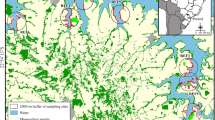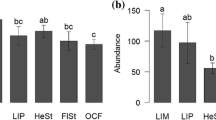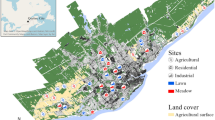Abstract
A mismatch of resource availability in certain periods can lead to spillover of insects between habitats, resulting in temporal differences in insect diversity. Urban gardens are important anthropogenic habitats but it is unknown whether, when and why spillover of beneficial insects occurs between gardens and agricultural habitats. We used trap nests for Hymenoptera to monthly monitor bee and wasp abundance and species richness in 12 gardens and 12 rapeseed fields. Half of the gardens and rapeseed fields were located in the urban–rural interface and bordered each other (a garden paired with a rapeseed field) and the other half were isolated in the rural landscape (isolated rapeseed fields) and in the urban city centre (isolated gardens). In general, gardens in the urban–rural interface comprised the highest richness of bees and wasps. The abundance of bees but not of wasps was highest in paired habitats and peaked at full rapeseed blooming, indicating that mass-flowering rapeseed offers foraging resources for bees nesting in adjacent gardens. Thus, bees nest and increase their populations in both areas, benefiting from the mass-flowering resource in the agricultural habitat as well as the nesting resources from gardens, suggesting spillover of bees but not of wasps between paired gardens and rapeseed fields. Our study highlights the value of gardens in the urban–rural interface for the biodiversity of functionally important insects. Implementing urban gardening and small-scale agriculture in cities and suburban habitats can promote local pollinator populations and benefit adjacent croplands.


Similar content being viewed by others
References
Ascher JS, Pickering J (2014) Discover life bee species guide and world checklist (Hymenoptera: Apoidea: Anthophila). http://www.discoverlife.org/mp/20q?guide=Apoidea_species. Accessed 16 February 2014
Bellmann H (2005) Bienen, Wespen, Ameisen: Hautflügler Mitteleuropas. Kosmos Verlags-GmbH, Stuttgart
Bianchi FJJA, Goedhart PW, Baveco JM (2008) Enhanced pest control in cabbage crops near forest in The Netherlands. Landsc Ecol 23:595–602. doi:10.1007/s10980-008-9219-6
Blitzer EJ, Dormann CF, Holzschuh A, Klein AM, Rand TA, Tscharntke T (2012) Spillover of functionally important organisms between managed and natural habitats. Agric Ecosyst Environ 146:34–43. doi:10.1016/j.agee.2011.09.005
Bolker B, Skaug H, Magnusson A, Nielsen A (2012) Getting started with the glmmADMB package: http://glmmadmb.r-forge.r-project.org/glmmADMB.html. Accessed 12 February 2014
Crawley MJ (2007) The R Book. Wiley, Chichester
Croci S, Butet A, Clergeau P (2008) Does urbanization filter birds on the basis of their biological traits? The Condor 110:223–240
Devroye L (1986) Non-Uniform Random Variate Generation. Springer, New York
Environmental Survey Research Institute (ESRI) (2011) ArcGIS Desktop: release 10. Environmental Systems Research Institute, Redlands
Fetridge ED, Ascher JS, Langellotto GA (2008) The bee fauna of residential gardens in a suburb of New York City (Hymenoptera: Apoidea). Ann Entomol Soc Am 101:1067–1077. doi:10.1603/0013-8746-101.6.1067
Garibaldi LA, Steffan-Dewenter I, Kremen C, Morales JM, Bommarco R, Cunningham SA, Carvalheiro LG, Chacoff NP, Dudenhöffer JH, Greenleaf SS (2011) Stability of pollination services decreases with isolation from natural areas despite honey bee visits. Ecol Lett 14:1062–1072. doi:10.1111/j.1461-0248.2011.01669.x
Gathmann A, Tscharntke T (1999) Landschaftsbewertung mit Bienen und Wespen in Nisthilfen: Artenspektrum, Interaktionen und Bestimmungsschlüssel (Biomonitoring using trap-nesting bees and wasps: community structure, interactions and identification keys). Naturschutz und Landschaftspflege Baden-Württ 73:277–305
Gathmann A, Tscharntke T (2002) Foraging ranges of solitary bees. J Animl Ecol 71:757–764. doi:10.1046/j.1365-2656.2002.00641.x
Giraudoux P (2012) Data analysis in ecology: package ‘pgirmess’. Repository Cran, version 1.5.4. R package version 0.7.2.12
Goddard MA, Dougill AJ, Benton TG (2010) Scaling up from gardens: biodiversity conservation in urban environments. Trends Ecol Evol 25:90–98. doi:10.1016/j.tree.2009.07.016
Goulson D, Hughes WOH, Derwent LC, Stout JC (2002) Colony growth of the bumblebee, Bombus terrestris in improved and conventional agricultural and suburban habitats. Oecologia 130:267–273
Goulson D, Lepais O, O’Connor S, Osborne JL, Sanderson RA, Cussans J, Goffe L, Darvill B (2010) Effects of land use at a landscape scale on bumblebee nest density and survival. J App Ecol 46:1207–1215. doi:10.1111/j.1365-2664.2010.01872.x
Grimm NB, Faeth SH, Golubiewski NE, Redman CL, Wu J, Bai X, Briggs JM (2008) Global change and the ecology of cities. Science 319:756–760. doi:10.1126/science.1150195
Gross H, Lane N (2007) Landscapes of the lifespan: exploring accounts of own gardens and gardening. J Environ Psychol 27:225–241
Hennig EI, Ghazoul J (2012) Pollinating animals in the urban environment. Urban Ecosyst 15:149–166. doi:10.1007/s11252-011-0202-7
Holzschuh A, Steffan-Dewenter I, Tscharntke T (2010) How do landscape composition and configuration, organic farming and fallow strips affect the diversity of bees, wasps and their parasitoids? J Anim Ecol 79:491–500. doi:10.1111/j.1365-2656.2009.01642.x
Hoyle M, Hayter K, Cresswell JE (2007) Effect of pollinator abundance on self-fertilization and gene flow: application to GM canola. Ecol Appl 17:2123–2135
Hudewenz A, Pufal G, Bögeholz AL, Klein AM (2013) Cross-pollination benefits differ among oilseed rape varieties. J Agric Sci. doi:10.1017/S0021859613000440
Kadlec T, Benes J, Jarosik V, Konvicka M (2008) Revisiting urban refuges: changes of butterfly and burnet fauna in Prague reserves over three decades. Landsc Urban Plan 85:1–11
Klein AM, Steffan-Dewenter I, Tscharntke T (2006) Rainforest promotes trophic interactions and diversity of trap-nesting Hymenoptera in adjacent agroforestry. J Anim Ecol 75:315–323. doi:10.1111/j.1365-2656.2006.01042.x
Kleyer M, Bekker RM, Knevel IC, Bakker JP, Thompson K, Sonnenschein M, Poschlod P, Van Groenendael JM, Klimeš L, Klimešová J, Klotz S, Rusch GM, Hermy M, Adriaens D, Boedeltje G, Bossuyt B, Dannemann A, Endels P, Götzenberger L, Hodgson JG, Jacke A-K, Kühn I, Kunzmann D, Ozinga WA, Römermann C, Stadler M, Schlegelmilch J, Steendam HJ, Tackenberg O, Wilmann B, Cornelissen JHC, Eriksson O, Garnier E, Peco B (2008) The LEDA traitbase: a database of life-history traits of the Northwest European flora. J Ecol 96:1266–1274
Krewenka KM, Holzschuh A, Tscharntke T, Dormann CF (2010) Landscape elements as potential barriers and corridors for bees, wasps and parasitoids. Biol Conserv 144:1816–1825. doi:10.1016/j.biocon.2011.03.014
Landesbetrieb für Statistik und Kommunikationstechnologie Niedersachsen: Bevölkerungsfortschreibung. http://www.lskn.niedersachsen.de. Accessed 25 January 2014
Liow LH, Sodhi NS, Elmqvist T (2001) Bee diversity along a disturbance gradient in tropical lowland forests of south-east Asia. J Appl Ecol 38:180–192. doi:10.1046/j.1365-2664.2001.00582.x
Loram A, Warren P, Gaston K (2008) Urban domestic gardens (XIV): the characteristics of gardens in five cities. Environ Manag 42:361–376. doi:10.1007/s00267-008-9097-3
Loram A, Warren P, Thompson K, Gaston K (2011) Urban domestic gardens: the effects of human interventions on garden composition. Environ Manag 48:808–824. doi:10.1007/s00267-011-9723-3
Magura T, Lövei GL, Tóthmérész B (2009) Does urbanization decrease diversity in ground beetle (Carabidae) assemblages? Glob Ecol Biogeogr 19:16–26. doi:10.1111/j.1466-8238.2009.00499.x
Matteson KC, Langellotto GA (2011) Small scale additions of native plants fail to increase beneficial insect richness in urban gardens. Insect Conserv Divers 4:89–98. doi:10.1111/j.1752-4598.2010.00103.x
Matteson KC, Ascher JS, Langellotto GA (2008) Bee richness and abundance in New York City urban gardens. Ann Entomol Soc Am 101:140–150
McFrederick QS, Le Buhn G (2006) Are urban parks refuges for bumble bees Bombus spp. (Hymenoptera: Apidae)? Biol Conserv 129:372–382. doi:10.1016/j.biocon.2005.11.004
McIntyre NE, Hostetler ME (2001) Effects of urban land use on pollinator (Hymenoptera: Apoidea) communities in a desert metropolis. Basic Appl Ecol 2:209–218. doi:10.1078/1439-1791-00051
McKinney ML (2008) Effects of urbanization on species richness: a review of plants and animals. Urban Ecosyst 11:161–176
Müller A, Krebs A, Amiet F (1997) Bienen: Mitteleuropäische Gattungen, Lebensweise. Beobachtung, Naturbuch
Pawelek JC, Frankie GW, Thorp RW, Przybylski M (2009) Modification of a community garden to attract native bee pollinators in urban San Luis Obispo, California. Cities Environ 2:1–20
R Development Core Team (2012) R: a language and environment for statistical computing. R Foundation for Statistical Computing, Vienna, Austria. ISBN 3-900051-07-0: http://www.R-project.org/
Rand TA, Louda SM (2006) Spillover of agriculturally subsidized predators as a potential threat to native insect herbivores in fragmented landscapes. Conserv Biol 20:1720–1729. doi:10.1111/j.1523-1739.2006.00507.x
Rand TA, Tylianakis JM, Tscharntke T (2006) Spillover edge effects: the dispersal of agriculturally subsidized insect natural enemies into adjacent natural habitats. Ecol Lett 9:603–614. doi:10.1111/j.1461-0248.2006.00911.x
Samnegård U, Person AS, Smith HG (2011) Gardens benefit bees and enhance pollination in intensively managed farmland. Biol Conserv 144:2602–2606. doi:10.1016/j.biocon.2011.07.008
Saure C (1996) Urban habitats for bees: the example of the city of Berlin. In: Westrich P, Williams IH, Matheson A, Buchmann SL, O’Toole C (eds) Linnean society of London and the international bee research association. The conservation of bees, London, pp 47–53
Scherber C, Mwangi PN, Temperton VM, Roscher C, Schumacher J, Schmid B, Weisser WW (2006) Effects of plant diversity on invertebrate herbivory in experimental grassland. Oecologia 147:489–500. doi:10.1007/s00442-005-0281-3
Schmid-Egger C (2004) Bestimmungsschlüssel für die deutschen Arten der solitären Faltenwespen (Hymenoptera: Eumeninae). Deutscher Jugendbund für Naturbeobachtung, Hamburg
Schüepp C, Herrmann JD, Herzog F, Schmidt-Entling MH (2011) Differential effects of habitat isolation and landscape composition on wasps, bees, and their enemies. Oecologia 165:713–721. doi:10.1007/s00442-010-1746-6
Skaug H, Fournier D, Nielsen A, Magnusson A, Bolker B (2012) Generalized linear mixed models using AD model builder. R package version 0.7.2.12
Smith RM, Gaston KJ, Warren PH, Thompson K (2006a) Urban domestic gardens (VIII): environmental correlates of invertebrate abundance. Biodivers Conserv 15:2515–2545. doi:10.1007/s10531-005-2784-y
Smith RM, Warren PH, Thompson K, Gaston KJ (2006b) Urban domestic gardens (VI): environmental correlates of invertebrate species richness. Biodivers Conserv 15:2415–2438. doi:10.1007/s10531-004-5014-0
Staniforth RJ (2002) Effects of urbanization on bird populations in the Canadian Central. Arctic 55:87–93
Stanley DA, Gunning D, Stout JC (2013) Pollinators and pollination of oilseed rape crops (Brassica napus L.) in Ireland: ecological and economic incentives for pollinator conservation. J Insect Conserv 17:1181–1189
Steffan-Dewenter I (2002) Landscape context affects trap-nesting bees, wasps, and their natural enemies. Ecol Entomol 27:631–637
Steffan-Dewenter I, Leschke K (2003) Effects of habitat management on vegetation and above-ground nesting bees and wasps of orchard meadows in Central Europe. Biodivers Conserv 12:1953–1968. doi:10.1023/A:1024199513365
Steffan-Dewenter I, Schiele S (2008) Do resources or natural enemies drive bee population dynamics in fragmented habitats? Ecology 89:1375–1387
Thies C, Roschewitz I, Tscharntke T (2005) The landscape context of cereal aphid-parasitoid interactions. Proc R Soc 272:203–210. doi:10.1098/rspb.2004.2902
Tscharntke T, Rand TA, Bianchi FJJA (2005) The landscape context of trophic interactions: insect spillover across the crop-noncrop interface. Ann Zool Fenn 42:421–432
Watling JI, Orrock JL (2010) Measuring edge contrast using biotic criteria helps define edge effects on the density of an invasive plant. Landsc Ecol 25:69–78. doi:10.1007/s10980-009-9416-y
Westphal C, Steffan-Dewenter I, Tscharntke T (2009) Mass flowering oilseed rape improves early colony growth but not sexual reproduction of bumblebees. J Appl Ecol 46:187–193. doi:10.1111/j.1365-2664.2008.01580.x
Westrich P (2011) Wildbienen: Die anderen Bienen. Verlag Dr. Friedrich Pfeil, München
Wojcik VA, McBride JR (2011) Common factors influence bee foraging in urban and wildland landscapes. Urban Ecosyst. doi:10.1007/s11252-011-0211-6
Zanette LRS, Martins RP, Ribeiro SP (2005) Effects of urbanization on Neotropical wasp and bee assemblages in a Brazilian metropolis. Landsc Urban Plan 71:105–121. doi:10.1016/j.landurbplan.2004.02.003
Acknowledgments
We thank the land and garden owners who allowed us to use their properties for this study. We acknowledge the help of Dr. Thomas Niemeyer with site selection and fieldwork, Isabel Siemers with plant species identification, Dr. Paul Westrich for reassurance of some bee species identities and numerous colleagues with fieldwork support. We thank the DAAD–Deutscher Akademischer Austauschdienst, Leuphana University Lüneburg and CAPES–Coordenação de Aperfeiçoamento de Pessoal de Nível Superior for funding this research.
Author information
Authors and Affiliations
Corresponding author
Electronic supplementary material
Below is the link to the electronic supplementary material.
Rights and permissions
About this article
Cite this article
Pereira-Peixoto, M.H., Pufal, G., Martins, C.F. et al. Spillover of trap-nesting bees and wasps in an urban–rural interface. J Insect Conserv 18, 815–826 (2014). https://doi.org/10.1007/s10841-014-9688-7
Received:
Accepted:
Published:
Issue Date:
DOI: https://doi.org/10.1007/s10841-014-9688-7




